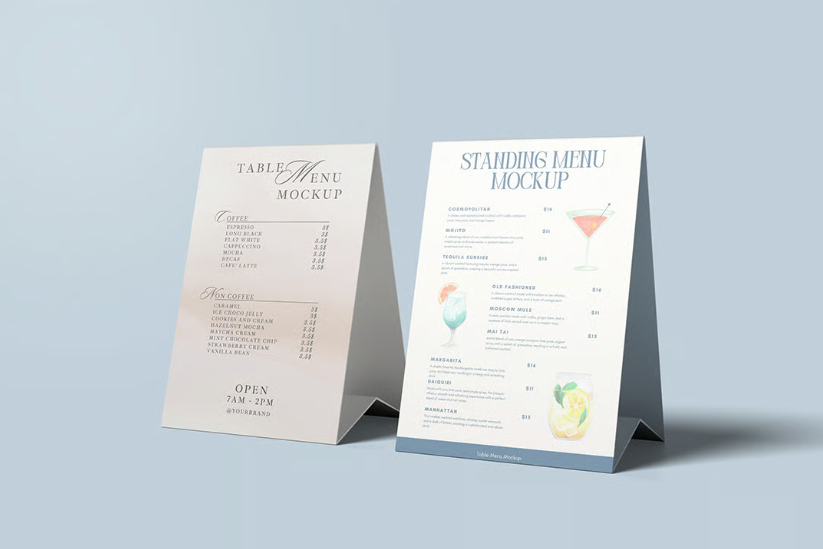As marketing strategies continue to adapt and diversify, many businesses are turning back to the power of physical mail to reach their audience. If you’ve started looking into mail based marketing, you’ve likely come across two popular methods:
Every Door Direct Mail (also known as EDDM) and Traditional Direct Mail.
While both aim to deliver messages directly to potential customers, they differ significantly in terms of targeting, cost, and overall execution. Knowing how they compare can help you make a smarter, more effective investment.
Whether you're a local bakery wanting to saturate your neighborhood or a national brand targeting a niche demographic, this blog will help you confidently choose the best mail strategy that suits your company's business goals.
What is Direct Mail?
Direct Mail is a widely used and time tested marketing tool that continues to deliver results. It involves sending physical marketing materials, such as postcards, brochures, or catalogs to a carefully selected list of recipients.
Whether you’re reaching out to loyal customers, prospective leads, or a targeted demographic list, the goal remains the same: to place your message directly into the hands of those most likely to engage with your brand.
According to a study conducted by RRD, 17% of consumers say direct mail is more likely to capture their attention, another 17% view it as more trustworthy, and 11% feel it delivers a more personal touch than email communications.

Common Types of Direct Mail
Direct mail offers a versatile and effective way to engage your audience, with a variety of formats tailored to suit different marketing goals.
Common types of direct mail include:
- Postcards: Ideal for quick, impactful messages and promotions.
- Self mailers: Folded pieces sent without an envelope, great for visual storytelling.
- Brochures: Informative and well structured, perfect for showcasing products or services.
- Flyers: Simple and budget friendly, often used for announcements or event promotions.
- Letters: Personalized messages delivered in an envelope, creating a more formal or intimate tone.
- Catalogs: Multi page booklets that display a wide range of offerings in one place.
- Package Inserts: Promotional materials placed inside shipments to encourage repeat business.
- Envelopes: Custom branded envelopes used to enhance professionalism and drive curiosity.
Each format offers unique advantages, allowing you to tailor your message and design for maximum impact. Direct mail continues outperforming email marketing, with an average response rate of 4.4%.
Benefits of Using Direct Mail Postcards
- Cost effective marketing with strong ROI.
- Quick to design, print, and mail.
- High visibility no envelope means your message is seen instantly.
- Ideal for promotions and announcements.
- Easy to personalize for targeted campaigns.
- Boosts brand recognition with eye catching visuals.
Businesses That Use Direct Mail
- E-commerce Brands
- Financial Institutions
- Real Estate Agencies
- Healthcare Providers
- Nonprofit Organizations
- Educational Institutions
- Retail
- Professional Service Providers
When to Use Direct Mail Services
Direct Mail is a smart option for businesses looking to connect with specific audiences through a more targeted and personalized approach. It’s especially effective when you want to deliver tailored messages or special offers to particular customer segments, increasing relevance and engagement.
With Direct Mail postcards, which require a mailing list, you also have the flexibility to design eye catching, high quality pieces, complete with custom finishes and enhancements, that make a strong and memorable impression.
Example Use:
A local dental clinic uses Direct Mail to promote its new cosmetic services by sending personalized postcards to nearby households. Targeting adults aged 30–60 with higher incomes, the mailers include spec
What is EDDM (Every Door Direct Mail)?
Every Door Direct Mail (EDDM) is a convenient mailing service from the United States Postal Service (USPS) that helps businesses reach potential customers in targeted geographic areas, no mailing list required. It’s an efficient way to connect with local households and neighborhoods, making it ideal for promoting store openings, special events, or regional services.
Rather than focusing on individual addresses, EDDM delivers your mail to every household along the specific postal routes you select within a chosen neighborhood or ZIP code. This broad coverage makes it an effective way to reach an entire community with minimal effort.
How EDDM Works Through USPS
EDDM is simple to use through USPS. Start by selecting your desired delivery routes using the USPS Every Door Direct Mail online tool. Next, choose the dates you’d like your mail to be delivered. Once your mailers are printed according to USPS size and labeling guidelines, you’ll drop them off at the appropriate USPS entry point for processing and delivery.
Mailing Tip: Utilize the tool to target customers based on key demographic factors, including age, household size, and income level.
Benefits of Using EDDM
When it comes to reaching your local audience efficiently and affordably, Every Door Direct Mail offers a range of benefits that make it a smart choice for businesses of all sizes, including
- Cost effective (no list purchase or mailing permit needed).
- Simple to set up via USPS.com.
- Perfect for local businesses wanting to saturate an area.
- You can select multiple routes for a single mailing.
Types of Businesses That Use EDDM
- Local Restaurants and Cafes
- Salons and Spas
- Lawn Care Services
- Retail Shops
- Real Estate Agents
- Home Services
- Gyms and Fitness Centers
- Churches and Community Organizations

When to Use EDDM
EDDM is an effective and practical option for businesses looking to reach a wide audience without the need for individualized messaging. It’s especially well suited for campaigns that use straightforward formats like postcards, which are quick to design, cost efficient to print, and simple to distribute. Since EDDM is not designed for urgent or time-sensitive promotions, it’s ideal for marketing efforts that align with standard delivery schedules.
This approach is especially effective for brick and mortar retailers, local service providers, and community based businesses looking to increase their visibility within specific neighborhoods or ZIP codes.
Example Use: A local pizza shop uses EDDM to promote a weekend special by sending postcards to every home within a three mile radius. The campaign is fast, affordable, and helps drive more foot traffic without the need for a mailing list.
Key Differences Between EDDM and Direct Mail
Both Every Door Direct Mail postcards and Direct Mail service offer valuable benefits for any size. Here’s a comparison of their key differences to help you determine which option best aligns with your marketing goals:
Targeting Capabilities
Direct Mail services offer highly targeted capabilities, allowing you to reach potential customers based on specific demographics, behaviors, or past purchase history. This level of precision makes it great for personalized campaigns.
EDDM, on the other hand, is designed for broader outreach. Instead of targeting individuals by name, it delivers mail to every address within a selected ZIP code, postal route, or neighborhood, making it effective for reaching a wide audience in a specific targeted area.
Statistic: EDDM postcard campaigns typically achieve response rates between 2.7% and 4.4%, particularly when the offer is well-targeted.
Design & Formatting Requirements
Direct Mail offers greater flexibility in design, allowing for a variety of sizes, personalized content, and creative formatting tailored to your audience.
Every Door Direct Mail postcards must follow specific USPS size guidelines. Eligible pieces must be flat mailers measuring between 6.125” x 11.5” and 12” x 15”, which can limit design options compared to traditional direct mail.
Mailing Lists & Data Usage
Direct Mail allows you to use rented or proprietary customer lists, giving you access to detailed demographic and behavioral data for more targeted messaging. Unlike Direct Mail, EDDM eliminates the need for a mailing list.
Your materials are simply addressed to “resident” or “occupant” and distributed to every household along the chosen postal routes, making it a practical option for broad, geographically targeted campaigns.
Costs and Budget Considerations
EDDM postcards typically offer lower upfront expenses when considering costs and budget, as there’s no need to buy or maintain a mailing list. This makes EDDM a cost effective solution for businesses looking to reach a wide local audience without stretching their marketing budget.
Direct Mail typically involves higher costs due to list acquisition and personalization, but it offers the advantage of precise targeting, potentially resulting in a higher return on investment by reaching the most relevant audience.
Turnaround Time & Setup
When it comes to setup and turnaround time, EDDM postcard mailing services offers a quicker and more streamlined process. Using USPS tools, you can easily select your target area and prepare your mail without the need for a mailing list.
Direct Mail generally requires a longer setup process, as it involves selecting or purchasing a mailing list, tailoring your message, and adding personalized touches to each piece for individual recipients.
Mailing Quantities
Direct mail offers flexibility in the types of items you can send and requires a minimum of 200 pieces to qualify for USPS bulk mailing discounts. Similarly, EDDM requires a minimum of 200 pieces per mailing; however, it comes with a cap of 5,000 pieces per day for each ZIP code.
Mail Sizes: EDDM vs. Direct Mail
Design flexibility and mailing size requirements vary considerably between EDDM and traditional direct mail, making it important to understand the specific guidelines for each method.
With EDDM, the USPS requires your mail pieces to fall within the flat mail category. That means your design must meet these specifications:
- Minimum Dimensions: 6.125" x 11.5"
- Maximum Dimensions: 12" x 15"
- Maximum Thickness: 0.75"
Traditional direct mail, whether sent individually or in bulk, offers greater design versatility across multiple formats. Here are the primary categories you can work with:
- Flats: From 11.5" x 6.125" up to 15" x 12"
- Mail Postcards: Ranging from 5" x 3.5" to 6" x 4.25"
- Letters: Minimum size of 5" x 3.5", with a maximum of 11.5" x 6.125"
Direct mail provides broader creative freedom if your campaign demands more variety in layout, format, or size, making it a more adaptable option for custom messaging.
Finding the Right Option
Deciding between the two marketing strategies comes down to your specific goals and business needs. For small businesses looking to reach local customers affordably, EDDM is a smart choic. It offers low postage rates and allows you to target entire neighborhoods without the need for a mailing list.
However, if your campaign requires reaching a specific demographic or involves sending a high volume of personalized materials, Direct Mail provides the precision and flexibility needed for more targeted outreach.
Both options offer distinct advantages, so take the time to evaluate your budget, audience, and campaign objectives to determine which mailing solution will deliver the best results for your business.




